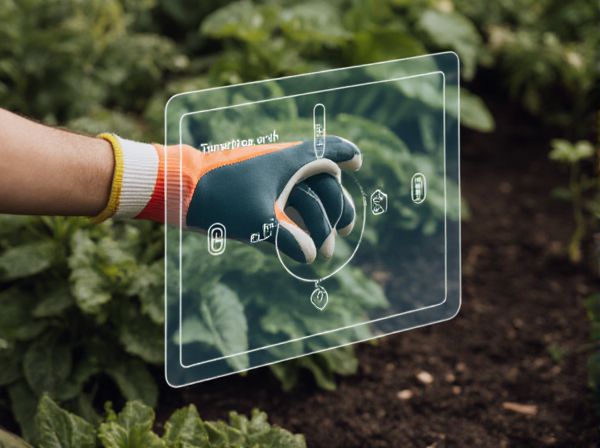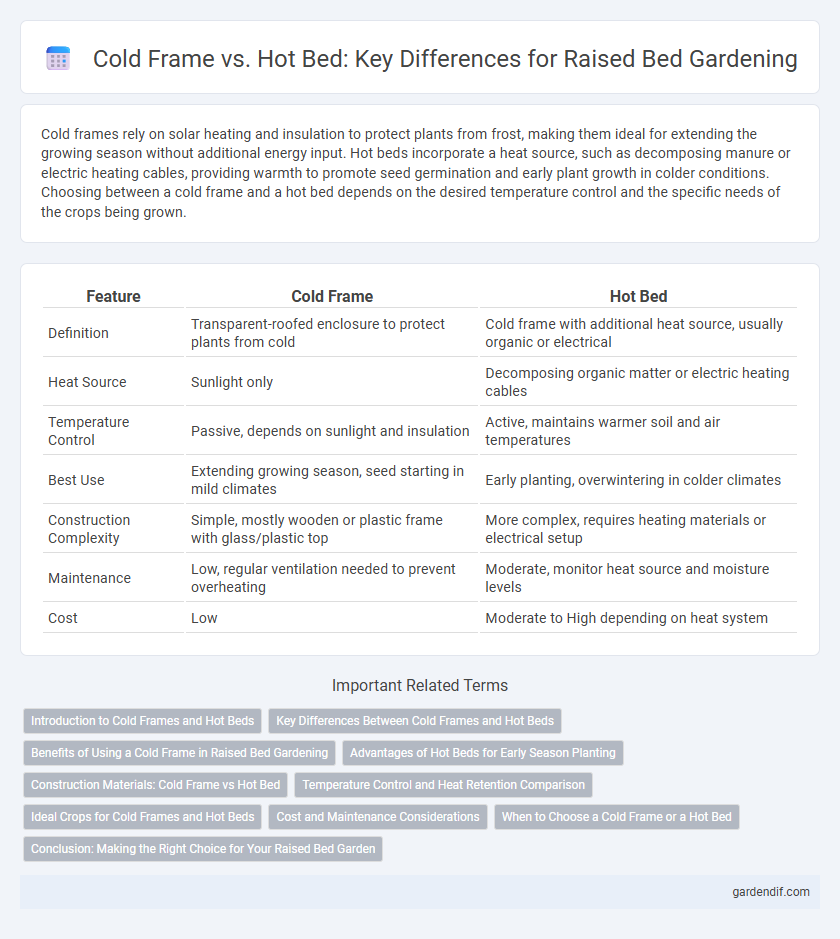
Cold frame vs Hot bed Illustration
Cold frames rely on solar heating and insulation to protect plants from frost, making them ideal for extending the growing season without additional energy input. Hot beds incorporate a heat source, such as decomposing manure or electric heating cables, providing warmth to promote seed germination and early plant growth in colder conditions. Choosing between a cold frame and a hot bed depends on the desired temperature control and the specific needs of the crops being grown.
Table of Comparison
| Feature | Cold Frame | Hot Bed |
|---|---|---|
| Definition | Transparent-roofed enclosure to protect plants from cold | Cold frame with additional heat source, usually organic or electrical |
| Heat Source | Sunlight only | Decomposing organic matter or electric heating cables |
| Temperature Control | Passive, depends on sunlight and insulation | Active, maintains warmer soil and air temperatures |
| Best Use | Extending growing season, seed starting in mild climates | Early planting, overwintering in colder climates |
| Construction Complexity | Simple, mostly wooden or plastic frame with glass/plastic top | More complex, requires heating materials or electrical setup |
| Maintenance | Low, regular ventilation needed to prevent overheating | Moderate, monitor heat source and moisture levels |
| Cost | Low | Moderate to High depending on heat system |
Introduction to Cold Frames and Hot Beds
Cold frames and hot beds are essential structures in gardening designed to extend the growing season by providing controlled environments. Cold frames use solar energy and insulation to protect plants from cold weather without additional heat, making them ideal for hardening off seedlings and growing cold-tolerant crops. Hot beds combine organic heating materials like compost underneath the soil to generate warmth, accelerating seed germination and supporting heat-loving plants during early planting stages.
Key Differences Between Cold Frames and Hot Beds
Cold frames rely solely on solar energy and ambient heat to protect plants, making them energy-efficient but dependent on external temperatures. Hot beds incorporate a heat source, often heated soil or electrical heating elements, providing consistent warmth for faster germination and growth. The key difference lies in temperature control, with hot beds offering regulated warmth, while cold frames depend on natural conditions.
Benefits of Using a Cold Frame in Raised Bed Gardening
Using a cold frame in raised bed gardening extends the growing season by protecting plants from frost and retaining heat naturally without the need for added heat sources. It improves seedling survival rates and hardens off young plants by creating a controlled microclimate that moderates temperature fluctuations. Cold frames require less maintenance and energy compared to hot beds, making them an eco-friendly and cost-effective solution for year-round gardening.
Advantages of Hot Beds for Early Season Planting
Hot beds provide superior warmth by incorporating decomposing organic material beneath the planting area, extending the growing season and enabling earlier seed germination compared to cold frames. Their enhanced soil temperature accelerates root development and plant growth, which is critical for early season vegetables such as tomatoes and peppers. Unlike cold frames, hot beds reduce the risk of frost damage and improve overall yield by maintaining a consistently warmer microclimate.
Construction Materials: Cold Frame vs Hot Bed
Cold frames typically utilize wood or plastic frames with transparent glass or polycarbonate lids, providing insulation through passive solar heating. Hot beds incorporate the same frame materials but include a heat source such as decomposing manure or electric heating cables beneath the soil, enhancing temperature control for plant growth. Both require sturdy construction to maintain durability and retain heat effectively, but hot beds demand additional insulation layers to optimize internal warmth.
Temperature Control and Heat Retention Comparison
Cold frames rely on solar radiation and insulation to maintain moderate temperatures, making them suitable for extending the growing season with minimal heat input. Hot beds incorporate a heat source such as decomposing organic matter or heating cables, allowing precise temperature control and higher heat retention for faster seed germination and early plant growth. Temperature in hot beds can be actively regulated to stay within optimal ranges, whereas cold frames depend more on ambient conditions and passive heat retention methods.
Ideal Crops for Cold Frames and Hot Beds
Cold frames are ideal for growing cool-season crops such as lettuce, spinach, kale, and radishes, extending their growing season by protecting plants from frost and harsh weather. Hot beds, heated by decomposing organic matter or external sources, are better suited for warmth-loving crops like tomatoes, peppers, and eggplants, as well as starting seeds earlier in spring. Both structures improve plant growth by creating controlled microclimates, but crop selection depends on temperature requirements and desired planting timelines.
Cost and Maintenance Considerations
Cold frames generally require lower initial costs and minimal maintenance since they rely on passive solar heat without a heating element. Hot beds involve higher expenses due to the integration of heating cables or mats and demand regular monitoring to maintain optimal soil temperature. Choosing between the two depends on budget constraints and the willingness to perform ongoing maintenance for enhanced seed starting conditions.
When to Choose a Cold Frame or a Hot Bed
Cold frames are ideal for extending the growing season in mild climates, providing protection for seedlings and hardy plants during early spring and late fall. Hot beds, equipped with an internal heat source such as decomposing manure or electric heating cables, are best chosen for starting seeds earlier in cold weather or growing heat-loving plants in low temperatures. Selecting between a cold frame and a hot bed depends largely on the ambient temperature and the specific heat requirements of the plants being grown.
Conclusion: Making the Right Choice for Your Raised Bed Garden
Cold frames provide a passive way to extend the growing season by using solar heat and insulation, ideal for gardeners seeking low-maintenance protection for seedlings and hardy plants. Hot beds generate warmth through decomposing organic matter, offering active heat ideal for early planting and tropical crops but requiring more upkeep. Choosing between cold frames and hot beds depends on your climate, plant needs, and willingness to manage heat sources in your raised bed garden.
Cold frame vs Hot bed Infographic

 gardendif.com
gardendif.com